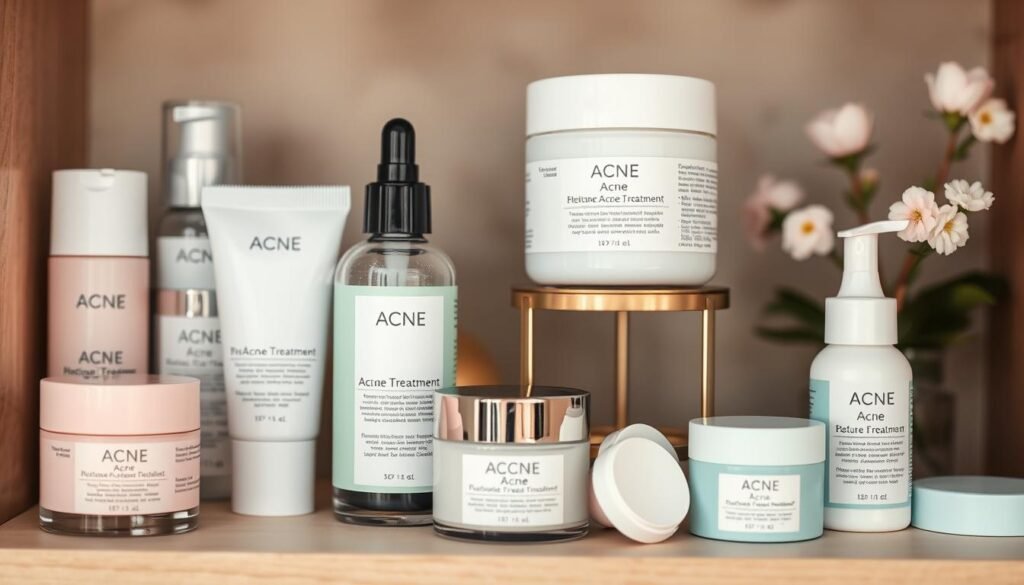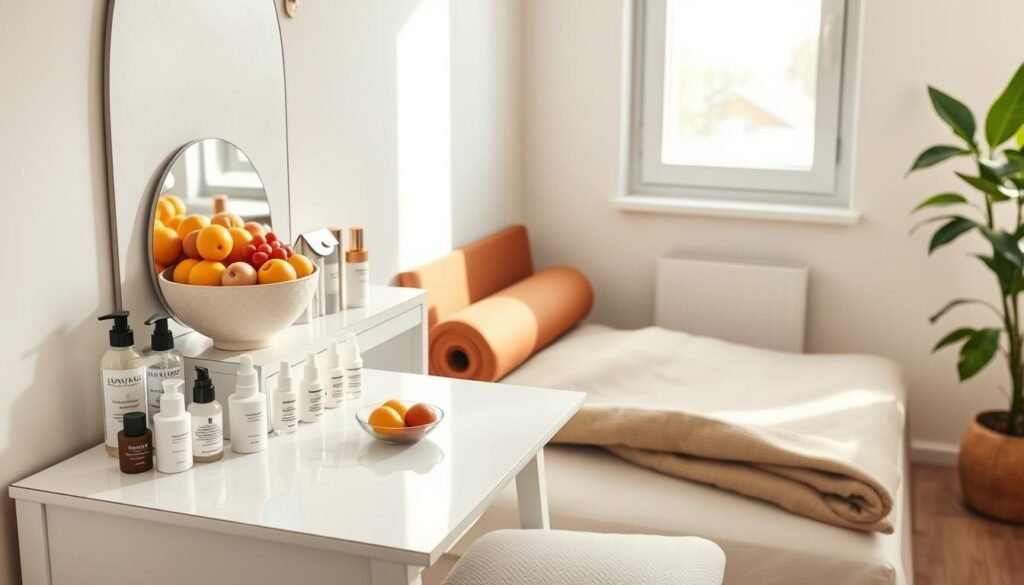Nearly 85% of people will face acne at some point in their lives. Nodular acne is a severe form that’s very painful. These are firm lumps under the skin that can scar without the right treatment.
This condition is more than a skin problem. It’s crucial to treat it quickly and correctly. This will help avoid worse issues later on.
We’ll cover what nodular acne is, including its symptoms and causes. You’ll also learn about the treatments available. It’s important to seek professional help when you need it. Knowing more about nodular acne is key to handling it well. For more details, look into specific treatments for nodular acne.
Key Takeaways
- Nodular acne is a severe form of Acne Vulgaris that requires timely intervention.
- Early treatment can help prevent scarring and infection associated with painful nodules.
- Both topical and oral medications are commonly prescribed to manage this type of acne.
- Stress management can play a key role in alleviating symptoms of nodular acne.
- For the best results, patients should consult a dermatologist for tailored treatment plans.
Understanding Nodular Acne
Nodular acne is a severe type of acne that causes solid, painful bumps under the skin. These bumps, red or pink, can stay for weeks or months. Unlike simpler acne forms, normal treatments don’t work well on it, making specialized care essential.
If you have painful skin nodules, getting help is key. Without treatment, nodular acne can leave deep scars. This condition often hits young men and adult women hard.
This acne can show up on the face, back, or other body parts. It often takes 3 to 4 months of treatment to see changes. Genetics, hormonal shifts, and lifestyle choices can all trigger nodular acne.
There are effective treatments available, like isotretinoin, antibiotics, and salicylic acid products. Cortisone shots can quickly help a single nodule heal faster. Even though treatments like peels and laser might not work alone, they can support other medications.
To manage nodular acne, good skincare habits are important. Always keep your face clean and use products that won’t clog pores. Avoid touching or picking at the skin bumps. Following these steps can reduce new breakouts and scars.
Differences Between Nodular Acne and Cystic Acne
Nodular and cystic acne are two difficult forms of acne vulgaris. They can greatly affect someone’s skin and how they feel about themselves. Knowing how they differ is key to treating them right.
Nodular acne leads to hard, swollen lumps under the skin. These nodules are painful and feel solid. Cystic acne, on the other hand, involves large, softer bumps filled with fluid. Both types can show up on the face, neck, back, and shoulders.
Both nodular and cystic acne can cause inflamed pimples and possibly scars. Nodular acne is more common in young men, while cystic acne often affects women, especially during their period. Your genes can also affect your chances of getting these conditions.
Regular acne products usually don’t work for nodular acne. Doctors may prescribe treatments like retinoids, antibiotics, or isotretinoin. Cystic acne may need fast treatment with corticosteroid injections to lower inflammation.

Even though people might use the terms nodular acne, cystic acne, and nodulocystic acne the same way, they are different. Cysts are a more severe form of nodular acne. Seeing a dermatologist early is crucial to avoid lasting damage to your skin.
Symptoms of Painful Nodules and Acne
People with nodular acne may find painful lumps under their skin. These lumps can be reddish and swollen, which are different from common acne spots. Nodules form deeply and feel hard and tender because they don’t have a head.
Painful nodules often pop up on the face, chest, and back. These spots can be very sensitive and hurt. They can make someone feel bad about how they look and feel. Because of this, finding a good treatment is crucial.
- Painful nodules under the skin
- Redness and inflammation
- Lasting presence for weeks or months
- Absence of a white head
- Potential scarring if untreated
It’s important to deal with nodular acne properly. Regular treatments might not work. Stronger medications or certain procedures might be needed. Talking to a dermatologist or doctor is key. They can create a treatment plan to help.
Causes of Nodulocystic Acne
Nodular acne is a severe type of Acne Vulgaris. It is caused by several factors. One main cause is the overactive sebaceous glands which produce too much oil. This oil mixes with dead skin, blocking pores and causing painful nodules under the skin.
Hormonal changes, especially in women, also play a big role. These changes can make the oil problem worse, nourishing acne-causing bacteria. If your family has a history of acne, you’re more likely to get nodular acne too. Genetics matter in this condition.
What you eat can affect how bad your acne gets. Foods high in sugar or dairy can make things worse. A balanced diet doesn’t cure acne but can lessen the breakouts.
To really understand nodular acne, it’s important to see how hormones, genetics, and oil production are connected. For those looking for deeper insights, detailed articles on nodular acne can be really helpful.
| Potential Causes | Description |
|---|---|
| Excess Oil Production | Overactive sebaceous glands result in clogged pores. |
| Hormonal Fluctuations | Hormonal changes, particularly in women, can worsen acne. |
| Genetic Predisposition | Family history increases the likelihood of developing severe acne. |
| Diet | Certain foods may aggravate symptoms, impacting overall skin health. |
Diagnosis and Tests for Nodular Acne
Dermatologists start diagnosing acne with a careful look and knowing the patient’s medical past. They can spot nodular acne in the first visit. This approach highlights the importance of professional evaluation.
Some situations call for further acne testing. Doctors might do bacterial cultures or allergy tests. These steps help find the causes of severe acne and prevent it from getting worse.
Getting the right diagnosis is key, as the American Academy of Family Physicians points out. Wrong diagnoses can lead to treatments that don’t work. This is especially true for stubborn acne.
| Diagnostic Method | Description |
|---|---|
| Visual Inspection | A dermatologist checks the skin for specific signs. |
| Medical History Review | It’s important to understand past skin issues and treatments. |
| Bacterial Cultures | These tests find bacteria that cause acne. |
| Allergy Tests | Doctors look for allergies that could make acne worse. |
Going through the diagnosis steps carefully helps in getting correct treatment. This way, people can manage their nodular acne well.
Painful Nodules and Acne: Treatment Options Available
Dealing with painful nodules from acne means using different treatments. Often, a mix of skin creams and pills works best, especially for serious acne.
Topical Treatments and Their Effectiveness
Topical treatments are widely used for nodular acne. Stronger, prescription-level ingredients like benzoyl peroxide and salicylic acid can reach deep to address acne causes. But, store-bought products might not be as effective for severe nodular acne.
To help, doctors may also suggest other methods:
- Acne extraction to remove cysts and nodules
- Corticosteroid injections for immediate relief
Oral Medications for Severe Cases
For more severe acne, pills are a key part of treatment. Some common types are:
- Antibiotics like doxycycline and minocycline to reduce swelling and bacteria
- Isotretinoin, shown to clear acne permanently for about 85% of those who try it once
- Hormone treatments, for women with acne linked to hormone changes
- Low-dose prednisone for specific conditions like acne fulminans
While treatments can take a few months to improve acne, good skincare habits are crucial. Continuing treatment after your skin is clear helps keep acne away.

| Treatment Type | Examples | Typical Use | Expected Duration for Results |
|---|---|---|---|
| Topical Treatments | Benzoyl Peroxide, Salicylic Acid | Target mild to moderate acne | 4-8 weeks |
| Oral Medications | Antibiotics, Isotretinoin, Hormonal Medications | Target moderate to severe acne | 2-3 months for initial improvement |
| Procedures | Extraction, Corticosteroid Injections | Instant relief and cyst/nodule removal | Immediate effect |
Preventing Scarring from Nodular Acne
It’s crucial to have an effective skincare routine to avoid acne scars, especially with nodular acne. People should use gentle care and pick the right products for their skin. These routines can help manage acne and prevent permanent scars.
Daily Skincare Routines
Having a daily skincare routine is key in preventing acne scarring. Here are some important steps:
- Use a gentle cleanser to wash the face twice daily.
- Choose non-comedogenic products to avoid clogging pores.
- Incorporate moisturizers that hydrate without adding excess oil.
- Apply sunscreen daily to protect sensitive skin from UV damage.
- Avoid picking or squeezing acne to minimize the risk of scars.
When to Seek Professional Help
There are times when seeing a professional dermatologist is needed. If nodular acne doesn’t get better or hurts more, a doctor can offer treatments that fit the person. Some situations might be:
- Severe breakouts that don’t respond to over-the-counter treatments.
- Signs of infection or significant swelling.
- Emotional distress caused by the appearance of acne.
Getting help early can make a big difference in skin health and lower the risk of color changes in the skin. It’s crucial to know when to seek help from a pro.
Lifestyle Changes and Their Impact on Acne
Nodular acne reaches many people, especially those aged 11 to 30. Around 80% could be affected, making it key to understand Lifestyle Changes for Acne. These changes greatly affect the Impact on Skin Health. They do so through diet, emotional health, and skincare routines.
A good diet is crucial for acne control. Studies show a low glycemic index (GI) and high-protein diet might reduce acne. Cutting down on dairy could also help, as it’s linked to more acne. On the other side, omega-3 rich foods like fish, nuts, and seeds can help clear your skin due to their anti-inflammatory effects.

Stress can make acne worse by messing with hormones. Stress Management is a vital acne treatment step. Meditation, yoga, and exercise can lower stress and help control acne. Getting enough sleep is also critical for balancing hormones and aiding skin health.
Using a gentle skincare routine is also important to avoid breakouts. Choose products carefully to avoid clogging pores or irritating skin. Eating antioxidants and dietary fiber helps too. Consider a Mediterranean diet for its whole foods, which could improve skin health.
| Lifestyle Change | Potential Benefit |
|---|---|
| Low-GI Diet | Reduces insulin spikes, may lower acne risk. |
| Stress Management Techniques | Helps regulate hormones, potentially reducing acne flare-ups. |
| Adequate Sleep | Supports skin regeneration and overall well-being. |
| Omega-3 Rich Foods | Reduces inflammation, helping to decrease acne severity. |
Adopting Lifestyle Changes for Acne can have a big, positive impact on your skin health. It leads to a clearer and more confident look. For those with nodular acne, combining these changes with medical advice is best for great results.
Conclusion
Nodular acne is a severe type of acne with large, painful bumps under the skin. It’s important to know about its causes and symptoms. This acne doesn’t get better with common acne treatments and needs strong medicine or professional care.
Delaying treatment can cause permanent scars. But early treatment with strong creams, antibiotics, or isotretinoin can help a lot. A good skincare routine, eating well, and not picking at the skin also make a difference.
Getting help from a doctor is key to dealing with painful acne nodules. With the right help and info, people can look better and feel better about themselves. This leads to a happier and more confident life.